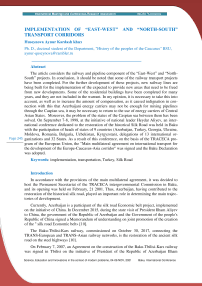Implementation of “East-West” and “North-South” transport corridors
Автор: Huseynova A.G.
Журнал: Science, Education and Innovations in the Context of Modern Problems @imcra
Статья в выпуске: 2 vol.4, 2021 года.
Бесплатный доступ
The article considers the railway and pipeline component of the “East-West” and “North-South” projects. In conclusion, it should be noted that some of the railway transport projects have been completed. For the further development of these projects, new railway lines are being built for the implementation of the expected to provide new areas that need to be freed from new developments. Some of the residential buildings have been completed for many years, and they are not included in the warrant. In my opinion, it is necessary to take this into account, as well as to increase the amount of compensation, as it caused indignation in con-nection with this that Azerbaijani energy carriers may not be enough for mixing pipelines through the Caspian sea, it may be necessary to return to the use of energy carriers of Central Asian States. Moreover, the problem of the status of the Caspian sea between them has been solved. On September 7-8, 1998, at the initiative of national leader Heydar Aliyev, an inter-national conference dedicated to the restoration of the historical Silk Road was held in Baku with the participation of heads of states of 9 countries (Azerbaijan, Turkey, Georgia, Ukraine, Moldova, Romania, Bulgaria, Uzbekistan, Kyrgyzstan), delegations of 13 international or-ganizations and 32 States. As a result of this conference, on the basis of the TRACECA pro-gram of the European Union, the "Main multilateral agreement on international transport for the development of the Europe-Caucasus-Asia corridor" was signed and the Baku Declaration was adopted.
Implementation, transportation, Turkey, Silk Road
Короткий адрес: https://sciup.org/16010109
IDR: 16010109


